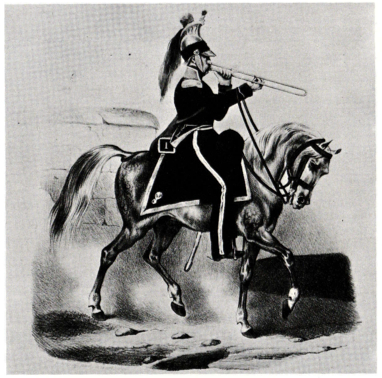November 20, 2008
Trombone History Timeline: Posted an entry from another primary source. This one, an English dictionary titled A New and complete dictionary of arts and sciences, printed in London in 1763-64, is noteworthy because it describes the sackbut, even at this relatively late date, as “a sort of trumpet,” and because it mentions multiple sizes of trombones.
November 19, 2008
•Alto Trombone Timeline: Added an alto trombone entry from an important 17th century primary source, Syntagma Musicum, vol. III (1619), a treatise by Michael Praetorius. Praetorius mentions the alto trombone several times throughout this particular volume, suggesting it for a number of different musical settings.
•Added an entry in both the Trombone History Timeline and the Alto Trombone Timeline on Kresser’s 12 Quatuors (1844), which are scored for either 4 cornets or 3 cornets and alto trombone. This piece is interesting because it is from France, where alto was not as common as it was in other regions, and because the date represents a time period in which the alto trombone is normally said to be in decline.
 November 17, 2008
November 17, 2008
•Trombone History Timeline: Added entries from 2 new primary sources: Francis North’s A philosophical essay of musick (1677) and a record of the coronation of George III from The Royal Magazine or Gentleman’s Monthly Companion (1761). Also added 2 lithographs of Belgian infantry trombonists (1831 and c. 1850), who seemed to favor rear-facing horns (see also Belgian infantry image of 1824). Also of note regarding trombone playing in Belgium during this period are comments by British travelers George Smart (see 1825) and Vincent Novello (see 1829).
November 7, 2008
•Trombone History Timeline: Finished posting works from the “Chronological Overview” of Klaus Winkler’s book, Selbständige instrumentalwerke mit Posaune in Oberitalien von 1590 bis 1650. The sheer number of instrumental pieces (Winkler lists more than 150) scored for trombone from this period and region (upper Italy from 1590 to 1680) is noteworthy. Why is it that one doesn’t hear more about early Baroque music for trombone? Most of us know Gabrieli’s music, for example, but what about all the sonatas of Castello and Buonamente or the canzoni of Banchieri and Picchi? There may be a body of original music we’re not really utilizing.
November 4, 2008
•Got a nice note about the historical parts of the site from Stewart Carter, Executive Editor of the Historic Brass Society Journal. (Added a link to Historic Brass Society under “Organizations” on front page.) He is working on a book on early trombone history, which I’m sure will be excellent. Stay tuned for details!
 October 28, 2008
October 28, 2008
•Trombone History Timeline: Posted color images of The Martyrdom of St. Lawrence, an oil painting from 17th century Mexico City by artist José Juárez. The painting depicts several angel-musicians, including an angel playing trombone. The numerous paintings and other entries indicating trombone activity in the region are noteworthy in trombone history because, for whatever reason, most brass historians make little or no mention of the trombone in colonial Latin America.
October 27, 2008
•Trombone History Timeline: Posted image from 18th century from the title page of Hirschberger’s Philomena Cisterciensis (Burghausen, 1743). Almost any trombone activity during this century is of interest, since historians point to this period as one of steep decline for the instrument.
October 24, 2008
•Trombone History Timeline: Posted several 19th century entries on Anton Bruckner, an important composer in the history of the trombone. Examples include his Zwei Aequale for 3 trombones, as well as numerous works for choir and trombones. The source is Keith William Kinder’s The Wind and Wind-Chorus Music of Anton Bruckner.
October 23, 2008:
•Trombone History Timeline and Alto Trombone Timeline: Added two entries about extant instruments from the 19th and early 20th centuries, with photographs used by the gracious permission of Brass Players Museum: www.neillins.com/brass.htm. The alto trombone, manufactured in England in the 1870s, is interesting in that it dates from the time of the supposed decline of the alto and is a valved instrument.
•Updated post about American Brass Quintet mini-residency at BYU. All events are open to the public! All events except the formal concert are free!
October 22, 2008:
•Trombone History Timeline: Posted entries from the 19th century on the career of German trombone virtuoso Carl Queisser, who performed as soloist at Leipzig’s prestigious Gewandhaus a remarkable 26 times–more than many of the era’s most famous instrumental soloists, including Paganini, Liszt, Hummel, and Clara Schumann. In light of the fact that many historians claim that trombone was never a solo instrument until well into the 20th century, the career of this prominent trombone soloist is truly intriguing. A respected music periodical of the time summed up Queisser’s influence thus: “Truly we live in an age of trombones.” Also added to the timeline are entries about trombone soloist Friederich Belcke, who seems to have paved the way for Queisser, as well as a few other soloists who followed Queisser. The information comes from Michael Lewis’s excellent article, “Solo Trombone Performances at the Gewandhaus” (ITA Journal, Summer 1992).
 October 20, 2008:
October 20, 2008:
•Added Spanish altarpiece with a young trombone-playing angel, dating from c. 1620-24 to Trombone History Timeline.
October 16, 2008:
•Added several entries about Moravian trombone playing in the 18th century to the Trombone History Timeline.
•Added 2 paintings by Italian artist Lionello Spada that include clear depictions of the trombone in the early 17th century.
October 13, 2008:
•Added newly-released Utah Trombone Authority CD to the Store. Check it out!